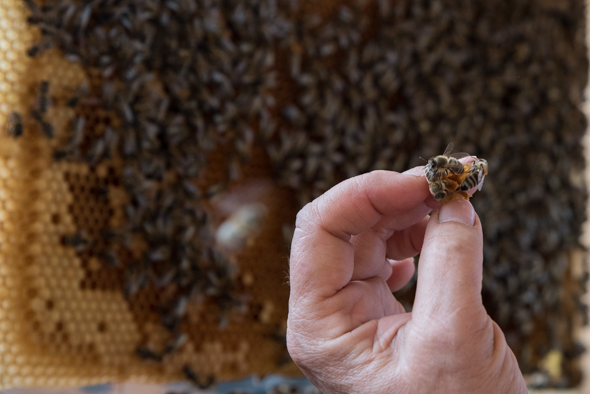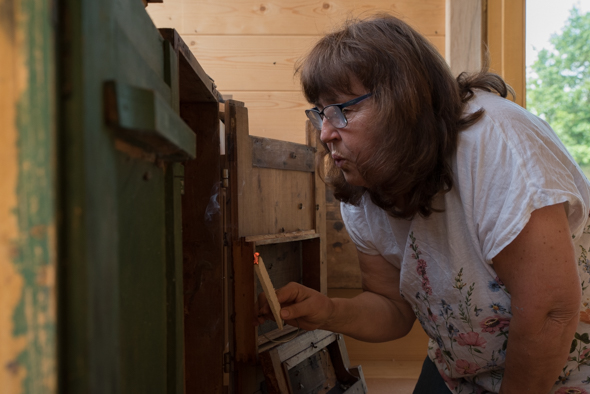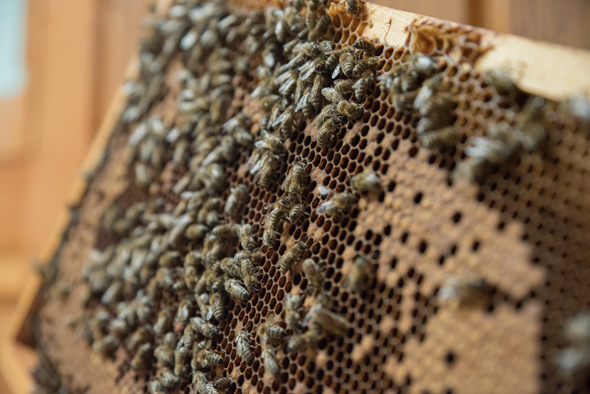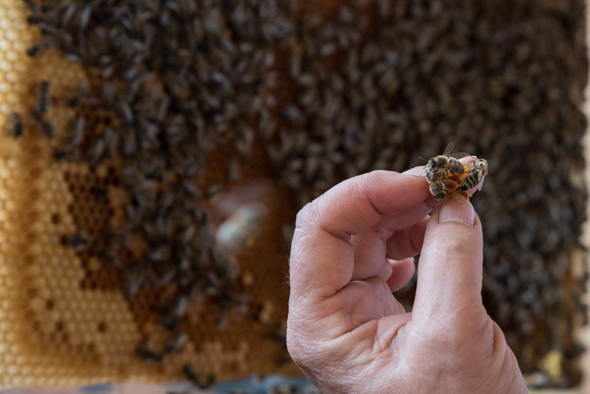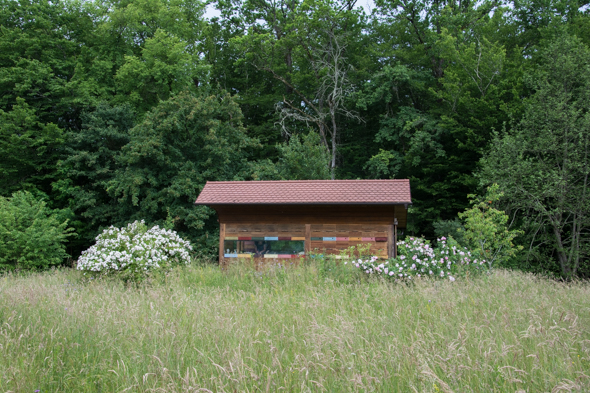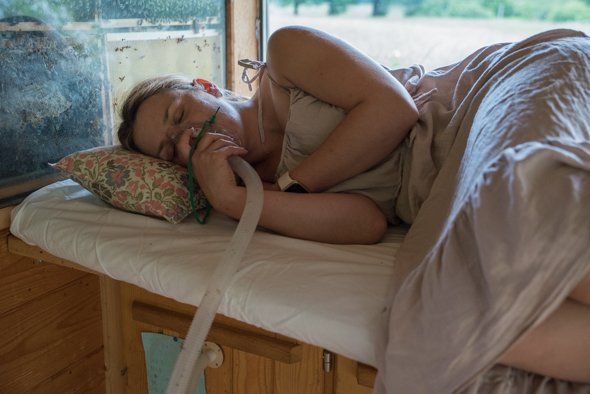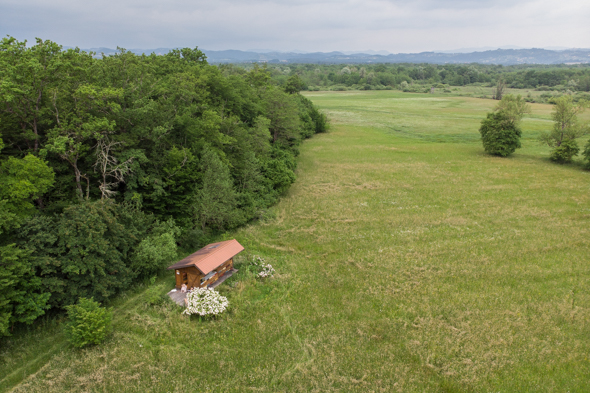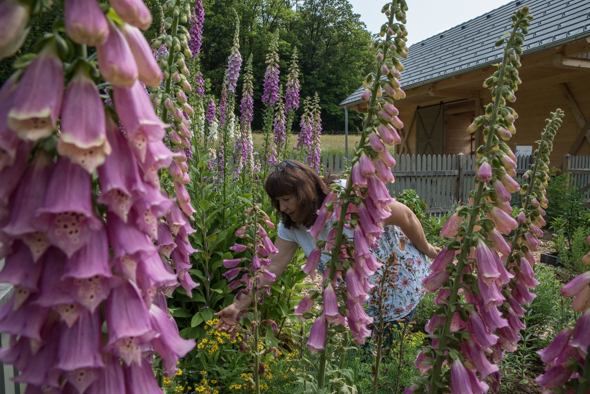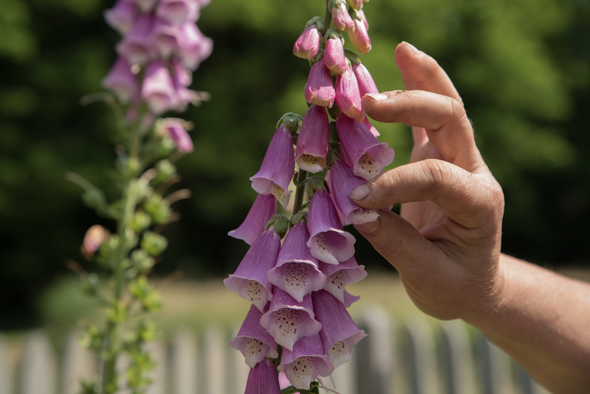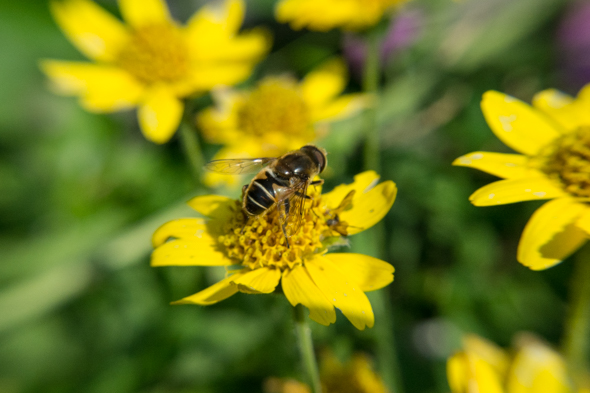Whilst the rest of the world worries about the decline in bees and the impact on food production, Slovenia has succeeded in reversing the trend over the past few years. Today, the country has become a veritable paradise for the yellow and black insects, cared for by more than 11,000 passionate beekeepers like Andreja Stankovič. As well as looking after the queens and their colonies, she teaches others the ins and outs of beekeeping and the secrets of the Slovenian model.
Andreja Stankovič opens the hive, takes out the honeycomb and carefully searches out the queen. Spotting her blue-dotted abdomen, Andreja softly pushes away the other dancing workers, picks up the queen with two fingers, gives her a twirl for everyone to admire and then gently kisses the tiny insect on the head. A few decades ago, there was a moment when she almost gave up on beekeeping. “One night, a woman with a mental illness closed all the hives. When I went to see them in the morning, all the bees, except for a single colony, were dead,” she explains. Heartbroken, she took the surviving bees to her balcony at home and refused to expand the activity until her father-in-law gave her three new colonies of bees as a birthday present. “That’s how I started beekeeping again,” she says. Today, she can’t imagine her life without the bees.
Andreja is one of the 11,349 beekeepers in Slovenia, taking care of around 200,000 bee colonies. The number of beekeepers and honeybees in Slovenia has been steadily rising, and has now finally reached maximum capacity – natural food in the environment is limited and more bees would increase the risk of faster transmission of bee diseases. “Years ago, experts estimated that the optimal number of bee colonies in the country is between 170,000 and 220,000, so we’re somewhere around the optimal number,” says Boštjan Noč, president of the Slovenian Beekeepers’ Organization.
Intensive agriculture and pesticides
However, just over a decade ago, things didn’t look so bright. In the spring of 2011, the communication centre in Pomurje, a predominantly agricultural region in the northeast of Slovenia, received a notification from several beekeepers about the death of thousands of bee colonies. The analysis confirmed the insecticide clothianidin, used to treat corn seeds, was to blame for the deaths. Soon after, the Ministry of Agriculture issued a regulation banning the use of clothianidin and other neonicotinoids, making Slovenia one of the first EU countries to adopt such a measure to protect bees. Noč, who started beekeeping at 13 years old with five colonies, affirms that it was the right decision: “We haven’t seen a massacre like that since.”
Pesticide use is among the three biggest drivers of pollinator decline in most parts of the world, warns the UN’s Food and Agriculture Organisation. In the document titled ‘Protecting pollinators from pesticides – Urgent need for action’, the FAO describe how overspraying and ingestion of contaminated pollen and nectar can result in the “direct mortality of the insects, but also adverse sub-lethal effects such as impaired foraging, reduced brood success, or perturbed homing ability,” naming bees as particularly vulnerable. Bees and other pollinators play a key role in our food production, 75 % of the crops humans use for food depend on pollinators. This year’s World Bee Day, celebrated on the 20th May and created by the United Nations at the initiative of Slovenia a few years ago, was thus focused on the promotion of pollinator-friendly agricultural production.
If I were a bee, I would want to live in Slovenia.
Boštjan Noč, who now owns almost 500 colonies, is convinced that the application of phytopharmaceuticals in food production is to some extent necessary. “But they must be used according to the manufacturers’ instructions, in the evening, when the bees are already in the hives,” he adds. According to this passionate and ambitious beekeeper, the key to success is in raising awareness and collaboration between beekeepers, farmers and other users of phytopharmaceuticals. He believes Slovenia has succeeded in solving the problem very well. “So we can be an example to the world”, the 49-year old president proudly says.
At the end of every March, with the beginning of the spraying season, the Slovenian Beekeepers’ Association and the Ministry of Agriculture implement a number of measures targeted at the general population as well as at professionals. They organise a nationwide media campaign, distribute posters and inform all stores selling such products that they have to warn customers about their correct use, either early in the morning or late in the evening when the bees are no longer grazing.
Andreja says that her relationship with the neighbours and the farmers is exemplary. “All my neighbours have always been very considerate of my bees, except for one. He always sprayed his orchard during the day when the bees were visiting the flowers,” she remembers. When she refused to give him the honey, he was surprised. “I told him his conduct would not only kill the bees but also leave him without any fruit, because the trees will be left unpollinated.” He quickly changed his attitude, Andreja confirms, adding that more and more people have been switching to ecological gardening and farming after visiting her apiary and being in direct contact with the insects. Noč confirms: “If I were a bee, I would want to live in Slovenia.”
Andreja Stankovič is the fifth generation of beekeepers in her family. She became a beekeeper overnight when she was still a university student. “When my father suddenly died, he left 50 bee colonies. Everybody wanted to buy them, but my mother and I decided to keep them and do our best in taking care of them,” she says. Despite her love for animals and the rudimentary knowledge she acquired from accompanying her father in harvesting honey, the challenge seemed overwhelming. “I was lucky it happened in November, so I had the whole winter to study. In the spring, the bees flew out of the apiary and all of them survived,” she explains, remembering the beginnings of her profession. When this happened in 1982, she was the youngest beekeeper around.
Since then, interest in beekeeping amongst young people has significantly increased. Over the last few years, the average age of beekeepers in Slovenia has been continually decreasing, a fact that Boštjan Noč attributes to the country’s unique system of beekeeping classes, carried out by beekeepers from regional and municipal beekeeping clubs in educational apiaries, set up in the vicinity of primary schools. According to Noč’s information, Slovenia has around 200 beekeeping school clubs, which means more than a quarter of primary schools have a beehive set up in the playground. “The interest among the youth is great; there are 2,500 children voluntarily attending these classes,” says Noč.
A family affair
Andreja and her daughter Tjaša Medreda Stankovič, who is also a beekeeper, have been passing on their knowledge to younger generations in Novo mesto, their hometown in southeast Slovenia. Since the town’s schools don’t have apiaries, children learn about the role and the importance of bees in their own apiary, situated at the edge of the forest. There they help harvest the honey, learn how the bee dances to show the rest of the hive where the pasture is rich in pollen, create artwork related to bees and build small bee hotels.
Tjaša is convinced it was written in her genes that she would become a beekeeper. As a child, she often accompanied her mother in taking care of the bees, which she considered pets. Over the years, her love of bees and nature grew, so she decided to follow her mother’s footsteps and become a beekeeper. During the holidays, she organises summer camps, during which at least one day is dedicated to the bees. “This year, children will spend one night in the apiary. When parents come to pick them up the next day, the kids will share freshly acquired knowledge with the grownups,” explains Tjaša with enthusiasm. “They also learn about consideration and respect. The majority of food comes to our table through pollinators, so it’s important to teach children about it,” Andreja says, looking at the portrait of her ancestors on the wall.
Due to the fact that the apiary is somewhat far from the town and is becoming a little too crowded, Andreja and Tjaša are building a new, larger one, right on the outskirts of Novo mesto. When finished, it will not only receive children, but everyone who is interested in the bees. Even now, while it’s still under construction, people stop by every day. “Recently, we got a visit from the students of Third Age University, while people with mental and psychical disabilities from the local Care and work centre frequently come by to make honeycomb frames, string combs or harvest the honey,” Andreja says whilst walking around her property.
For people who would like to become more professionally involved in beekeeping, the Slovenian Beekeepers’ Association offers numerous educational and training workshops. According to its president, it organises at least five 40-hour beekeeping courses for beginners every year, as well as many other targeted seminars, such as courses on natural pest control and courses on apitherapy. “Most of them are free of charge,” he adds. Noč is convinced that no other country in the world has such a strong educational system at all levels.
Slovenians don’t keep bees for the honey, but rather for the love of bees.
Despite the high popularity of beekeeping in the country, honey yields, on the other hand, are very low. Data, provided by Noč, confirms that while the number of beekeepers and bees has been on the rise, the number of colonies per beekeeper has been decreasing, suggesting apiculture is turning into a hobby, where the profit from the sale of honey is less important. According Boštjan Noč’s figures, the average Slovenian beekeeper owns 17 bee colonies, with which he or she produces 15kg of honey per beehive in a good season, while in some countries this number can reach 150kg. Andreja says that Slovenians don’t keep bees for the honey, but rather for the love of bees. However, Slovenians do have other benefits from the buzzing insects.
As soon as she stepped into the apiary, Tjaša grabbed a plastic mask connected to the hives by a tube, put it on her mouth and lay down on the bed. On one side, she could see the greenery of the meadow and the forest, on the other, bees danced tirelessly behind the glass wall. Beneath her, she felt the buzzing of bees, giving off relaxing vibrations. “I’ve been a bit ill with a lung infection, so I really needed to inhale some of those healing aerosols,” she explained. When she decided to become an official beekeeper, she engaged in it with the desire to “do something differently”. She decided to focus on apitherapy and honey massage. After completing both a beekeeping course and a classic massage course, she is now preparing to obtain a national professional qualification certificate as an apitherapist.
Apitherapy is the ancient practice of using honeybee products for medicinal purposes that we’ve all been applying by consuming honey, propolis and royal jelly. Recently, other types of apitherapy have been gaining popularity in Slovenia: inhaling air that is rich in pollen and other substances that bees collect in nature and mix in the hive, lying on a bed above the hives, therapy with bee stings and honey massages. These practices boost not only physical but also mental health, the beekeepers claim.
Back in my grand-parents' time, it wasn’t called apitherapy, but the effects were the same.
The traditional Slovenian apiary, a wooden building where the beehives are stored under the roof and which is large enough for the beekeeper to enter, is, according to our interlocutors, particularly suitable for this type of therapy. Andreja recalls how years ago her grandfather had a divan placed in the apiary, where he used to relax after Sunday mass. “Back then, it wasn’t called apitherapy, but the effects were the same.” In the following decades, beekeepers along with Andreja have modernised the interior of the apiary, making it more effective, comfortable and accessible to other visitors.
Ten years ago, Andreja built her apiary with the help of funds from the European Union. The two-year project that united Andreja, the local beekeeping association and the agricultural school in Novo mesto, cost around €65,000, and around 85 percent of this amount was funded by the EU’s Agricultural Fund for Rural Development, under a project LEADER programme. Thanks to this support, Andreja designed her apiary in such a way so that as many people as possible could benefit from it in as many different ways as possible. In addition to the construction of an apiary, the group organised workshops on apitherapy for beekeepers and spas, a natural history day for children, workshops on the preparation of honey dishes for students of catering and tourism schools and the production of leaflets and postcards for the promotion of apitherapy and other activities for the general public. The wooden construction is a home for the bees, a place for children to learn about the importance of pollinators, a place for patients with asthma and allergies to treat their respiratory problems with aromatherapy and inhalation, and where other visitors come for Tjaša’s honey massages.
Flowers for honeybees
Sometimes, the effects of nature prevail over all human efforts. Andreja Stankovič and Boštjan Noč agree that this year has been extremely difficult for the bees. Constant rain during April and most of May washed off all the pollen, leaving the animals hungry. Andreja emphasises the seriousness of the situation: “Until now, in my more than 40-year long beekeeping career, there hasn’t been a single year where we haven’t harvested honey by June at least once.” This year, so far, she hasn’t harvested a drop.
For Noč, climate change with sudden bouts of cold air and long periods of rain, poses the biggest threat to the bees. Scientists argue that increasing crop diversity and habitat conservation is one way of promoting biodiversity and mitigating climate change. In practice, this means planting honey plants and keeping the fields and the meadows blooming.
April is the month when the fields in Slovenia turn yellow. The flowers of the rapeseed, used to produce oil, invigorate the landscape, slowly awakening after a long, grey winter. In the following months, corn, barley, wheat, oat and rye offer swathes of green fields. However, in August, when most of the crops have been harvested, the fields become empty, brown and lifeless again leaving little pasture for the pollinators. To change this, in 2014, The Beekeeper’s Association of Slovenia, together with many partners from the field of agriculture, launched the Kar sejemo, to žanjemo project (“we reap what we sow”), which promoted the planting of honey-bearing types of buckwheat, a local undemanding plant that grows well on infertile soils, is resistant to drought and doesn’t require pesticides. “Planting buckwheat benefits both the bees, who get food, and the farmers, who can earn extra money with the crop,” Noč insists.
Now, in August, carpets of small white flowers again attract bees producing dark, aromatic and highly valued buckwheat honey. According to the data from the Statistical Office of the Republic of Slovenia, the area of buckwheat in the country more than doubled between 2014 and 2022. Although Andreja’s main activity isn’t farming, she joined the movement and also planted buckwheat in 2014 and she will do the same again this year.
The road to the old apiary leads through a forest, then suddenly ends in front of an immense meadow. Driving becomes difficult, as the grass reaches at least halfway up the car. Andreja and her neighbours intentionally leave the grass unmowed so the pollinators can graze on flowering plants. She and other beekeepers have been urging farmers and other actors to mow the lawns late, when the flowers have already bloomed. Some Slovenian municipalities have already responded to these calls by mowing public areas less often. The European Union has also been addressing the problem by subsidising farmers for the late harvest.
Andreja created a green oasis just outside the new apiary she affectionately named “The Honey Garden”. She slowly walks among the hundreds of plants, gently caressing the leaves and colourful flowers that attract the bees, butterflies and other insects. Some of the plants are already in full bloom, while others are barely forming the buds. Many of them are medicinal, some are also poisonous, but all of them flower profusely in different seasons, providing the bees with rich pasture throughout most of the year.
While explaining the healing effect of individual flowers, she playfully encloses a loud bumblebee in a huge purple flower and after a few seconds sets him free. “The garden doesn’t only attract pollinators, but also people who stop by while hiking along the nearby Krka river,” she says. During these meetings with passers-by, who take pictures and admire the richness of colours and smells, Andreja always tells them: “Even if you only have a small balcony, you should plant honey plants for the bees.” As for her, she will keep on building her new apiary, plant medicinal flowers and take care of the bees, with the same optimism and joy.
This story is part of the YOUTHopia campaign, a journalistic project shedding new lights on the EU Cohesion Policy.
The lynx are back
Once deserted by lynxes, the forests of the Dinaric Alps are once again inhabited by these felines. The species have been reintroduced by the LIFE Lynx programme, in which Slovenia, Croatia and Italy, as well as the animals’ countries of origin, Romania and Slovakia, are all involved. As the project draws to a close in a year’s time, Rok Černe, its coordinator, takes stock of the situation.
ereb: Why did you decide to focus on this animal and not another species?
At the beginning of the 20th century, the lynx population in the Dinarics went extinct due to habitat loss, lack of prey species and overhunting. In 1973, the lynx was successfully reintroduced by hunters and foresters who translocated 6 lynxes from Slovakia to Slovenia. Their goal was to bring back an animal that was once part of these forests. However it was not protected at the time so legal hunting was allowed. The animals then expanded to the neighbouring countries (Croatia, Bosnia and Herzegovina, Italy and Austria), but unfortunately, after a few decades, the population started declining, mainly due to genetic deterioration (inbreeding). Before the start of the LIFE Lynx project, genetic analysis revealed that we probably only had a few more years before complete population collapse.
ereb: How did you proceed to prevent this extinction?
For the project, 18 lynxes were captured in Romania and Slovakia, and translocated to Slovenia and Croatia, where they were released into nature. All of them are equipped with telemetry collars, which enable us to closely monitor their integration into the population. With the help of camera traps, some very interesting lynx-stories were revealed.
ereb: Which ones?
The Romanian lynx, Goru, was the first lynx translocated to Slovenia and after his release we were able to confirm that he had at least three litters with a local female Teja. We were able to closely monitor their encounters in the mating season, because both of them were wearing collars. We consider Goru one of the most successful translocated lynxes as he fulfilled his role of transferring healthy genes to the Dinaric-Se Alpine lynx population.
Another interesting story came from the Alps; five animals were translocated to this area in 2021 and all of them established territories there. Female lynx, Julija, had three male kittens in 2022 and we were able to fit all of them with telemetry collars, which is the first time an entire litter of kittens has been monitored with telemetry, which will show us how and where they will establish their own territories. One of the goals of the project is to create a stepping stone population in the Alps, and these young lynxes are the first steps towards realising this goal.
ereb: This programme relies on the collaboration of five countries but also with hunters, who used to kill lynx.
Yes, for successful reinforcement and conservation of the lynx, key stakeholders are involved in the process, especially local communities and hunters – our key group. We collaborated with them in different project activities (camera trapping, telemetry, lynx releases, … ). And with this, we managed to maintain their strong support for lynx conservation.
